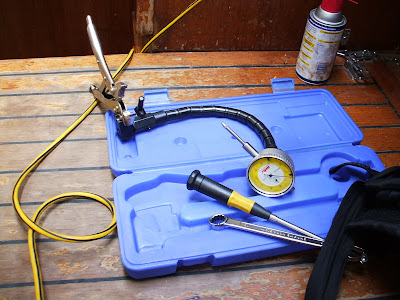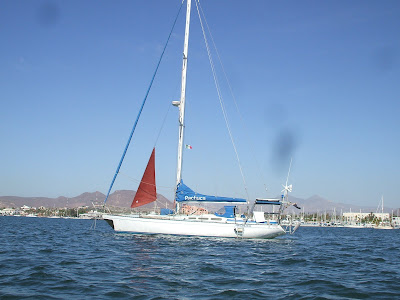
Joel visited the boat yesterday to assess the propeller shaft. I expected him to simply look at the shaft while it rotated but instead he used a dial gauge (pictured) that I had never seen before. He found that between the stern tube and the transmission coupling the shaft is .032" out of true. He then went to a lot of trouble (because of rust and corrosion) to decouple the prop shaft from the transmission. I then went over the side and turned the propeller while he did his measurement and he found that the free shaft was .010" out of true. He then recoupled the shaft so that I could drive the boat to the lifter.
I then went to the boat yard and got a shock at the prices.
A package of liftout (both ways), 3 days hardstand, and the labor for antifouling is $648 USD (all prices will be in US dollars). Thereafter the hardstand charge is $50 per day, with no weekly or monthly rates. I've just checked the current rates at the Port Townsend Boat Haven and found that their two way liftout charge for a 40 ft boat is $278.24 and their monthly hardstand rate works out to $8.32 per day. Welcome to sunny Mexico where the living is easy and the yachties get gouged.
The current plan (which sometimes changes by the hour) is to do nothing until the Volvo engine arrives. At that point I will have the boat lifted out and have the shaft removed for assessment. If it can be straightened out I should have it back in a day or two. In the meantime I will have two coats antifouling put on. I will have to supply the paint which is priced at $230 per gallon. I asked that the antifouling be raised about 2 " to the top of what is currently enamel boot topping. That will cost an extra $130. I asked for a quotation for painting a new enamel boot topping 2" wide above the antifouling and that cost came in at $430 which I consider outrageous. I've done the job myself in less than half a day but I will not be allowed do any exterior work (i.e. hull and deck) while on the hard stand.
The only good news was the cost of a crane which is only $100. So we will use a crane to lift out the Sabb engine. They would prefer lift the engine out before Pachuca is hoisted out of the water, but of course I need the engine to get to the lift, which means that I'll need time to free the engine for lifting.
Neil suggested that I have the engine bed work done at the boat yard because they have very good fiberglassing and other skills. That sounded like a great idea to me until I figured out last night that at $50 per day I would be under pressure to hurry the job. My inclination is to put the boat back in the water as soon as possible and have the engine bed and installation work done here in the slip as originally plan. At least the heavy Sabb engine would have been lifted out intact.
But returning the boat to the slip will require that the boat has a propeller shaft. If the current shaft cannot be straighted then I will have a problem because only shafts of 316 grade stainless steel is available locally. That would mean bringing one in from the USA, which would mean more delay.
I have paid 2 months in advance for this slip, which is costing about $18 per day. On top of that I will be paying about $60 per day for a hotel room for the duration of the engine work, and within that span I will be paying $50 per day for the hardstanding. That's OK. I'll just have to think of the literally months out at sea on my return to Australia living within the confines of the boat while the pension checks keep rolling in.
Brenda's Bird of the Day is an international bird of prey: the Peregrine Falcon. This bird was flying was flying with some difficulty as it had another large (deceased) bird in its talons. It landed well up a communications tower just near the marina, where it began to pluck and eat its victim.

















































